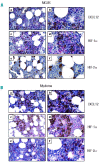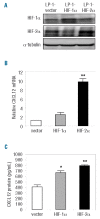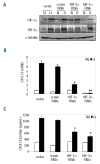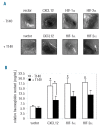Hypoxia-inducible factor-2 is a novel regulator of aberrant CXCL12 expression in multiple myeloma plasma cells
- PMID: 20015878
- PMCID: PMC2864384
- DOI: 10.3324/haematol.2009.015628
Hypoxia-inducible factor-2 is a novel regulator of aberrant CXCL12 expression in multiple myeloma plasma cells
Abstract
Background: Multiple myeloma is an incurable malignancy of bone marrow plasma cells. Progression of multiple myeloma is accompanied by an increase in bone marrow angiogenesis. Studies from our laboratory suggest a role for the CXCL12 chemokine in this process, with circulating levels of CXCL12 correlating with bone marrow angiogenesis in patients with multiple myeloma. While the mechanisms responsible for aberrant plasma cell expression of CXCL12 remain to be determined, studies in other systems suggest a role for hypoxia and hypoxia-inducible transcription factors.
Design and methods: The expression of hypoxia-inducible factor protein was examined in patients' bone marrow biopsy specimens using immunohistochemistry. The hypoxic regulation of CXCL12 was examined in multiple myeloma plasma cell lines using polymerase chain reaction and western blotting. The role of hypoxia-inducible factors-1 and -2 in the regulation of CXCL12 expression was examined using over-expression and short hairpin RNA knockdown constructs, electrophoretic mobility shift assays and chromatin immunoprecipitation. The contribution of CXCL12 to hypoxia-induced angiogenesis was examined in vivo using a subcutaneous murine model of neovascularization.
Results: Strong hypoxia-inducible factor-2 protein expression was detected in CD138(+) multiple myeloma plasma cells in patients' biopsy specimens. Prolonged exposure to hypoxia strongly up-regulated CXCL12 expression in multiple myeloma plasma cells and hypoxia-inducible factor-2 was found to play a key role in this response. Promoter analyses revealed increased hypoxia-inducible factor-2 binding to the CXCL12 promoter under hypoxic conditions. Over-expression of hypoxia-inducible factor in multiple myeloma plasma cells strongly induced in vivo angiogenesis, and administration of a CXCL12 antagonist decreased hypoxia-inducible factor-induced angiogenesis.
Conclusions: Hypoxia-inducible factor-2 is a newly identified regulator of CXCL12 expression in multiple myeloma plasma cells and a major contributor to multiple myeloma plasma cell-induced angiogenesis. Targeting the hypoxic niche, and more specifically hypoxia-inducible factor-2, may represent a viable strategy to inhibit angiogenesis in multiple myeloma and progression of this disease.
Figures






Comment in
-
Novel drugs for the treatment of multiple myeloma.Haematologica. 2010 May;95(5):702-4. doi: 10.3324/haematol.2009.021550. Haematologica. 2010. PMID: 20442442 Free PMC article. No abstract available.
Similar articles
-
Biological aspects of angiogenesis in multiple myeloma.Int J Hematol. 2011 Dec;94(6):505-18. doi: 10.1007/s12185-011-0963-z. Epub 2011 Nov 17. Int J Hematol. 2011. PMID: 22086206 Review.
-
HIF-2α Promotes Dissemination of Plasma Cells in Multiple Myeloma by Regulating CXCL12/CXCR4 and CCR1.Cancer Res. 2017 Oct 15;77(20):5452-5463. doi: 10.1158/0008-5472.CAN-17-0115. Epub 2017 Aug 30. Cancer Res. 2017. PMID: 28855206
-
miR-15a and miR-16 affect the angiogenesis of multiple myeloma by targeting VEGF.Carcinogenesis. 2013 Feb;34(2):426-35. doi: 10.1093/carcin/bgs333. Epub 2012 Oct 26. Carcinogenesis. 2013. PMID: 23104180
-
HIF-2α-ILK Is Involved in Mesenchymal Stromal Cell Angiogenesis in Multiple Myeloma Under Hypoxic Conditions.Technol Cancer Res Treat. 2018 Jan 1;17:1533033818764473. doi: 10.1177/1533033818764473. Technol Cancer Res Treat. 2018. PMID: 29656700 Free PMC article.
-
Impact of hypoxia on the pathogenesis and therapy resistance in multiple myeloma.Cancer Sci. 2021 Oct;112(10):3995-4004. doi: 10.1111/cas.15087. Epub 2021 Aug 9. Cancer Sci. 2021. PMID: 34310776 Free PMC article. Review.
Cited by
-
Hypoxia promotes dissemination of multiple myeloma through acquisition of epithelial to mesenchymal transition-like features.Blood. 2012 Jun 14;119(24):5782-94. doi: 10.1182/blood-2011-09-380410. Epub 2012 Mar 6. Blood. 2012. PMID: 22394600 Free PMC article.
-
Progenitor/Stem Cells in Vascular Remodeling during Pulmonary Arterial Hypertension.Cells. 2021 May 28;10(6):1338. doi: 10.3390/cells10061338. Cells. 2021. PMID: 34071347 Free PMC article. Review.
-
The left-right Pitx2 pathway drives organ-specific arterial and lymphatic development in the intestine.Dev Cell. 2014 Dec 22;31(6):690-706. doi: 10.1016/j.devcel.2014.11.002. Epub 2014 Dec 4. Dev Cell. 2014. PMID: 25482882 Free PMC article.
-
Integration of hypoxic HIF-α signaling in blood cancers.Oncogene. 2017 Sep 21;36(38):5331-5340. doi: 10.1038/onc.2017.119. Epub 2017 May 22. Oncogene. 2017. PMID: 28534514 Review.
-
Biological aspects of angiogenesis in multiple myeloma.Int J Hematol. 2011 Dec;94(6):505-18. doi: 10.1007/s12185-011-0963-z. Epub 2011 Nov 17. Int J Hematol. 2011. PMID: 22086206 Review.
References
-
- Rajkumar SV, Leong T, Roche PC, Fonseca R, Dispenzieri A, Lacy MQ, et al. Prognostic value of bone marrow angiogenesis in multiple myeloma. Clin Cancer Res. 2000;6(8):3111–6. - PubMed
-
- Vacca A, Ribatti D, Roncali L, Ranieri G, Serio G, Silvestris F, et al. Bone marrow angiogenesis and progression in multiple myeloma. Br J Haematol. 1994;87(3):503–8. - PubMed
-
- Koshiba T, Hosotani R, Miyamoto Y, Ida J, Tsuji S, Nakajima S, et al. Expression of stromal cell-derived factor 1 and CXCR4 ligand receptor system in pancreatic cancer: a possible role for tumor progression. Clin Cancer Res. 2000;6(9):3530–5. - PubMed
-
- Salvucci O, Yao L, Villalba S, Sajewicz A, Pittaluga S, Tosato G. Regulation of endothelial cell branching morphogenesis by endogenous chemokine stromal-derived factor-1. Blood. 2002;99(8):2703–11. - PubMed
-
- Moller C, Stromberg T, Juremalm M, Nilsson K, Nilsson G. Expression and function of chemokine receptors in human multiple myeloma. Leukemia. 2003;17(1):203–10. - PubMed
Publication types
MeSH terms
Substances
LinkOut - more resources
Full Text Sources
Medical

